Gifted Tactics in the Field
September 01, 2015
Editor's Note: In the following package of field reports, School Administrator asked four school districts to share their experiences about serving students who are capable of learning well beyond the current grade level. They were invited to address four different aspects of a district’s work in educating those identified as gifted academically.
One district in a remote, rural community describes its approach. Another district details how it has expanded participation of those student groups typically underrepresented in gifted programs. A third school district addresses the manner it tackled a poor program evaluation of its gifted services. And, finally, a district shows how it is using synchronous distance learning to meet these students’ academic needs.
Gifted Services in a Small, Rural Community
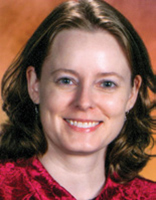
My small, rural district in northwestern Montana has a 35-year track record of providing gifted services for students. It’s a community with mixed demographics and high poverty, yet we’ve been able to offer a comprehensive approach without breaking the bank.
About 140 gifted students, or 8 percent of the district’s 1,650 students, attend our four Title I schools. Because we are located on the Flathead Indian Reservation, 30 percent of the students are American Indian. The gifted students’ demographics reflect those of the district’s population.
Gifted students need a variety of services, but not every gifted learner needs every item on the menu. A continuum of services ensures that their varying needs can be met more individually.
Our menu in Polson includes thinking skills activities, subject acceleration, whole-grade acceleration, early entrance to kindergarten, dual enrollment, small-group pullout, independent learning and in-depth projects.
Additional key programming features involve teacher collaboration; support for parents; consultations with individual students, teachers and parents; and a comprehensive identification process using multiple measures that begins in kindergarten and maintains an open window throughout the K-12 years. These measures are both observation-based and data-based.
Starting Realistically
How should a small, rural school district with limited staffing begin?
Talk to some kids. Ask your teachers to give you the names of a few of their most gifted and advanced learners and then seek their input on what school is like for them. When do they feel challenged? How often is school too easy? What could the teachers do to reach them better? Hearing it straight from the students is an eye-opening way to understand what is, or is not, happening for these learners.
Seek volunteers for a gifted programming committee. Start with those who understand the intense need and value of providing unique services for unique learners. Ideally, these individuals would have had some training in gifted education, but since that training can be sparse, you may have to begin with a few teachers and parents who have demonstrated their interest and knowledge in this area in other ways (e.g., by differentiating in their classrooms, by advocating for advanced opportunities for students, etc.)
Start small. Pick three to five goals for the first year and focus on them. One goal might be to explore identification processes and services and choose the paths that best suit your district. Another goal might be to examine staffing and decide who and how many FTEs you can devote to coordination and implementation of these services. Assess your progress, tweak the issues and proceed further the next year. Establishing an effective program takes time.
Remember that gifted students are in all populations. These students exist wherever you are. Mythology about what “gifted” is lends to the misbelief that it is only about the rare Einstein. Yet high potential abounds.
Realize no district is too small, too rural or too poor to provide gifted services. Services for gifted and advanced learners can cost little or nothing. Any school can flexibly group students by readiness for a content area, and this does not require additional staffing. It only requires assessing which students are ready for which level of the content and grouping them accordingly (whether within or across grades). Cluster grouping gifted learners and whole-grade acceleration (“grade skipping”) also do not require additional staff nor funds, and are both research-proven ways to benefit advanced learners. Even staffing a full-time gifted and talented position is a small fraction of a percent of a total district budget, even in a small district.
Don’t assume one measure can or even should identify all gifted students. Accept that identification never will be clear-cut. Stereotypes about giftedness exist, but in truth, gifted children come in all varieties. Some excel academically and some are underachieving. Some are from wealthy families, others are homeless. Some excel in many areas and some shine in just one. The gifted often are nonconformists, and they may not exhibit classroom-friendly behaviors as they ask challenging questions and point out the teacher’s mistakes. Some are endearing pleasers who turn in perfect work; others are class clowns and troublemakers on the road to suspension.
Acknowledge what you already do for gifted students — then ask, “What’s next?” Most districts can point to appropriate pieces of a menu of services for these students. Look for what already is happening (e.g., a teacher who is a master at differentiation; the school that groups students by readiness and re-assesses groupings regularly; the Academic Bowl coach who already is mentoring standout students on strategies for seeking a challenge and then meeting it). Then build on the foundation you may not have realized you already had.
Seek guidance from those who specialize in gifted education. The National Association for Gifted Children (www.nagc.org) offers a wealth of online resources. You don’t have to go it alone. Thousands of passionate individuals with expertise can help.
Online and Face-to-Face Delivery Synchronously
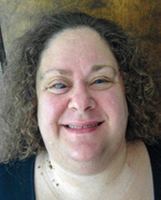
It’s 9:10 a.m. on a Tuesday. Clare and her 4th-grade classmates have dispersed into leveled reading groups. Clare takes her headset/microphone combo from her desk, grabs a laptop from the cart and joins Delante at the door. Together, they travel to the conference room, greet the principal in his office, choose seats around the conference table and turn on their laptops.
“Good morning, Delante, Clare,” their gifted intervention specialist teacher, Mrs. G., greets them from a camera feed in the corner of each laptop screen. Over her shoulder, they see five classmates waving hello. “The vocabulary starter for the day is on the whiteboard. Clare, you’re the blue marker, and Delante the green. We’ll discuss the possibilities as soon as everyone’s here.”
Mrs. G. and her students are located in a school across town. She directs the students to begin the word-etymology activity, which is a feature of the distance learning software. Clare clicks the small blue box at the top of the whiteboard and moves her mouse to write her answer; Delante chooses the green box, clicking an additional button to allow him to type his answer on the screen. While Clare and Delante are working, two students appear in smaller camera feeds below the image of Mrs. G.’s classroom, joining the class from School B and School C. Clare finds it difficult to concentrate because she’s excited about the prospect of being paired with her new friend Mia, the student from School C, to work on a project.
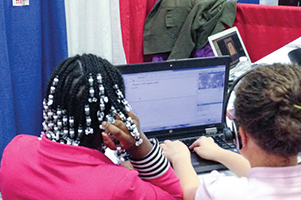
“Who would like to start?” asks Mrs. G., as the camera pans to show the students in her room. The class begins to discuss a word problem. The principal peeks in then drifts over to join Delante’s camera feed, only to drift out again when his walkie-talkie beeps.
Clare and Delante, both identified as gifted in reading, join Mrs. G. and their seven other classmates for 40 minutes of reading enrichment each day. Since 2012-13, these synchronous distance-learning classrooms have operated across the 20,000-student Akron, Ohio, school district. By 2014-15, every one of the district’s 32 elementary schools had at least one student participating in this gifted service-delivery option.
Akron began using the Measures of Academic Progress test to assess all students in grades K-10 in 2013-14. Under Ohio law, the test can be used to identify students as gifted. As a result, nearly twice as many students have been identified as gifted in reading and/or math in grades 3-5, and all have access to gifted services using the new distance learning delivery. In addition, the district offers gifted services to identified students at its two specialty middle schools — a visual-performing arts school and a STEM school — and to students in high school via Advanced Placement courses, the International Baccalaureate Program and college course options.
Before 2012, when the online service began, the district’s five gifted intervention specialists traveled to schools with the largest number of identified gifted students and pulled students out of classrooms for enrichment. Yet only some schools got a daily visit. A state audit in 2011 found these services inequitable. With the help of the Ohio Department of Education, Akron developed a plan for providing gifted service opportunities for all identified 3rd through 5th graders in reading and math. The online delivery option enables the district to provide access to all who qualify, no matter the school of attendance.
After weighing options — using a central location for instruction, asynchronous distance learning and the traveling teacher — the district chose to connect gifted students via real-time, online classrooms. This model maximizes teacher time
and maintains the social and emotional benefits of a resource room while making services available to every student who qualifies for them. “It’s important for gifted students to be together each day,” explains Mrs. G., who has taught
gifted students for eight years, “especially because some students are the only identified gifted students in their grades or schools.”
Leading Challenges
To make such a bold move successful requires ongoing communication and support and updates to curriculum for the gifted when districtwide curriculum changes are made. Gifted teachers receive training in how to use WebEx (video conferencing software) and Moodle (a learning management system), as well as in how to engage online and face-to-face students at the same time.
Akron’s commitment to online learning has resulted in an expanded its technology support staff so teachers and students have help with their online connections each day. Gifted students can use laptops provided by the LeBron James Family Foundation that also support after-school initiatives.
Two big challenges remain: (1) the need for communication between the gifted teacher and the students’ teachers in the satellite locations and (2) the alignment of student schedules across multiple classrooms and buildings. However, the benefits outweigh the difficulties. More students have equitable access. They are connecting with their intellectual peers, while honing the 21st-century skills of collaboration, technology use and independence.
Program Evaluation As a Wakeup Call

All means all in Mankato Area Public Schools, where we take our mission seriously: “Assuring learning excellence and readiness for a changing world.” When we fall short, we act.
In gifted education, serving all students means looking objectively at school district practice, committing to change and making it happen.
Two years ago, Mankato Superintendent Sheri Allen commissioned an external review of gifted and talented services in our district of 7,800 students in south-central Minnesota. National experts Karen Rogers and Karen Westberg, both University of St. Thomas professors of special education and gifted education, conducted a comprehensive review of curriculum, instruction and programming — a process that collected input from students, parents, teachers and administrators.
Their study revealed serious structural and program weaknesses. The shortcomings included identification processes, curricular scope and sequence, professional development and support for families. Few economically disadvantaged, culturally diverse, English language learners and twice exceptional students participated in gifted and talented programs.
Reform Initiative
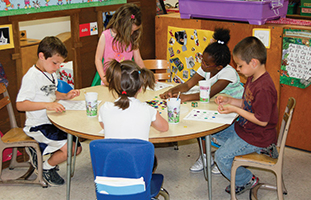
Using the review as a wakeup call, the district immediately expanded to a preK-12 Talent Development Program and hired a full-time coordinator. Rogers and Westberg helped us apply for a federal grant under the Jacob K. Javits Gifted and Talented Students Education Program. The three-year grant provides $200,000 annually to support these collaborative activities:
- Develop a defensible and inclusive student identification process.
Mankato’s revamped elementary identification processes to use multiple measures in selecting students for advanced academic programming. Equal weight is given to measures of ability and achievement, which includes academic trend data rather than one score.
This restructuring included a universal screening of 3,000 students in grades 2-6 with the Cognitive Abilities Test-Screening Form, known as the CogAt.
The district obtained local norms on the CogAt to deepen understanding of its students who scored significantly higher than the national norms. This decision was based on recommendations from the National Association of Gifted Children and experts Joseph Renzulli, Rogers and Westberg.
Using the CogAt and Measures of Academic Progress scores, the district generated potential candidates for talent development services. Teachers also could nominate students. We gathered feedback using online instructional rating scales for students being considered.
All test scores and rating scales were normed and converted to standard scores to use in a weighted formula for statistical consistency for student selection. A selection committee identified students for services using an eight-step process that created multiple pathways into services. The district added an appeals process for student identification decisions.
The process of using local norms led the district to understand students in context with each other, identify those students underchallenged by current programming and plan more effectively to serve their educational needs.
Educators districtwide are now using CogAt scores as another data point to serve students more effectively — especially traditionally underserved learners. More students are now receiving talent development services, and those students are increasingly diverse. A Rising Scholars Program helps support the needs of underserved learners.
- Provide continued professional development for teachers and administrators.
The universal screening and identification process gave the district a much better understanding of the academic needs of local gifted and talented students. These needs drive student programming and professional development. The district uses the Response to Intervention model with Tier 1, 2 and 3 services to meet students’ advanced academic needs and to train teachers in programming to meet these needs.
At Tier 1, classroom differentiation in core instruction takes place. For Tier 2, new resources and strategies provide greater complexity and a faster pace in core subjects. Tier 3 offers a more individualized approach and includes independent study and subject or grade acceleration.
Reading and math coaches provide job-embedded professional development and share research-based best practices in gifted and talented education.
Each year, about 150 educators will have workshop training to address teachers’ attitudes and assumptions of giftedness, to increase teachers’ knowledge of differentiation and to train teachers in interventions. School administrators attend an annual leadership academy to help them support the needs of gifted learners.
Through the University of St. Thomas, nearly 40 educators are enrolled in free graduate courses to earn a Gifted, Creative and Talented Certificate and/or a Twice Exceptional and Underserved Learners Certificate.
- Train and support families of students receiving talent development services.
This fall, the district is offering families learning opportunities around the unique needs of both mainstream and traditionally underserved learners.
- Provide a scope and sequence of appropriately differentiated curricula for grades 1-10.
As part of the RTI system, the district is implementing gifted and talented reading/English language arts curricula for 2015-16. The district is building the scope and sequence of differentiated curricula in reading/English language arts, math, science and social studies.
Ending Indifference
The many changes in gifted and talented education are helping Mankato intentionally serve diverse students.
As Ernest Boyer, the late president of the Carnegie Foundation for the Advancement of Teaching, said, “You can’t have an island of excellence in a sea of indifference.”
Broadening the Scope for the Underrepresented
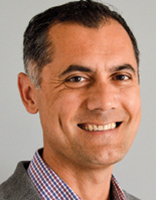
It is a Thursday morning, and Pam Schwarz, gifted intervention teacher at Woodson Kindergarten Center in Austin, Minn., is conducting one of her Young Scholars groups. The four boys in the group are typical kindergarteners — unable to sit still and excitedly blurting out answers even after being reminded that it is important to raise their hands. But if you listen carefully, you will notice this diverse group of boys is analyzing narration for a story based on pronoun use as well as making advanced predictions and connections. This is the heart of gifted services in Austin.
Located in southeastern Minnesota, Austin is best known as the birthplace of SPAM. Our school system of approximately 4,800 students has been experiencing rapid shifts in population. During the past 10 years, the number of home languages spoken has increased from 18 to 57, the percentage of nonwhite students has increased from 20 to 41 percent, and the percentage qualifying for free and reduced-price lunch has increased from 41 to 57 percent.
Through significant partnerships, the Austin district has developed a service model for its most able learners that enhances our ability to serve underrepresented populations, especially in grades K-4.
Ending Identification

Seven years ago, we entered into a partnership with the Hormel Foundation and the Minnesota Department of Education to improve gifted and talented services with the goal of increasing the equity and access of gifted programming.
The foundation’s funding helps the district provide 3.5 gifted and talented intervention positions, serving the district’s all-day, every-day kindergarten center and four neighborhood elementary schools with grades 1-4. These interventionists focus on enrichment activities and talent development through programs like Young Scholars.
The district has moved to a “right fit right now” model of delivery and has forgone traditional identification. Students meet with the gifted and talented interventionists based on their demonstration of mastery of material delivered in general classrooms at that time. As a result, the number of students from underrepresented populations receiving gifted and talented support has increased.
Earlier this year, the district opened Pi Academy, a full-time gifted services center for those who qualify by being in the top 2 percent of students in the district based on a combination of achievement and ability assessment scores. We renovated space in an elementary building to create an ungraded environment. To meet students’ interests and needs, Pi Academy uses one-to-one technology, flexible learning and a highly interest-based curriculum based on their ability levels.
Another component is staff development. This has been accomplished at both the community and instructional levels. Austin hosts an annual four-day gifted and talented symposium that brings in national and international experts on gifted education. All district parents and educators attend at no cost, thus increasing the community’s knowledge of gifted education. The six symposia have attracted more than 1,000 attendees, including international attendees from Hong Kong, Kenya and Turkey.
Austin teachers can receive gifted and talented certification from nearby St. Mary’s University at no cost, and to date, 20 have done so.
Cognitive Capacity
Finally, a significant shift has occurred in how students have been identified owing to the work of our gifted and talented interventionists. Beyond our use of achievement measures, students who demonstrate high ability, especially in the nonverbal components of the Cognitive Abilities Test, are offered talent development. This is also a key component in identifying students from more diverse backgrounds for the fledgling Pi Academy.
During 2014-15, our district served 355 students in our gifted program, up from 215 just three years prior. Of those served, 21 percent are Hispanic, 9 percent are black, 24 percent are considered English language learners and 48 percent qualify for free or reduced-price lunches.
Notably, almost 12 percent are students in special education. This is largely due to the inclusion of CogAT into the assessments for consideration.
Only through the partnerships with a generous foundation and the state education agency has our district been able to secure the know-how and necessary funding. We’ve broadened our district’s scope of talent development to be more inclusive and to allow a group of wiggly kindergarteners a chance to explore their full potential.
About the Authors
John Alberts is executive director of educational services for the Austin Public Schools in Austin, Minn. E-mail: john.alberts@austin.k12.mn.us. Twitter: @alberts_john. Tania Lyon is the talent development coordinator for Mankato Area Public Schools in Mankato, Minn. E-mail: tlyon1@isd77.k12.mn.us. Twitter: @Tania_Lyon1. Rachel Smethers-Winters is the coordinator for gifted and talented education in Akron Public Schools in Akron, Ohio. E-mail: rbs45805@akron.k12.oh.us. Tamara Fisher is the K-12 gifted education specialist for Polson School District 23 in Polson, Mont. E-mail: tfisher@polson.k12.mt.us. Twitter: @thethinkteacher
Advertisement
Advertisement
Advertisement
Advertisement



